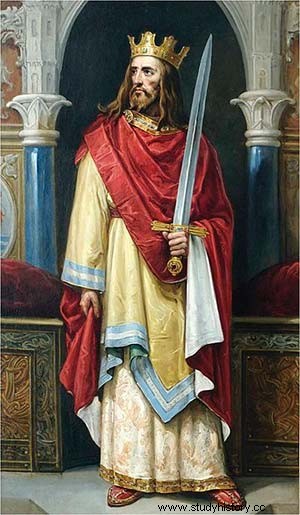Juan II (1406-1454) acceded to the throne as a child, so it was necessary to establish a regency, of which his mother, Catherine of Lancaster , was a part. , and his uncle, the infante Don Fernando . The latter, conquered, in the year 1410, the Plaza de Antequera, taken from the Muslims of Granada, became King of Aragon in 1412 by virtue of what was agreed in the Compromise of Caspe. But Fernando left his children in Castile, the so-called "infants of Aragon", very well installed. These infants were Juan, Duke of Peñafiel; Enrique, Master of the Military Order of Santiago, and Sancho, Master of the Military Order of Alcántara .
Soon a confrontation will arise between the "infants of Aragon", who wanted to be essential in the government of Castile, and the monarch Juan II, who had Don Alvaro de Luna as a man of confidence. This character was of Aragonese origin who quickly climbed positions in the court of the Castilian monarch. Alvaro de Luna's main objective was to strengthen royal power to the maximum. The relationship between the king of Castile and his favorite was so close that, according to what is said in the Chronicle of the falconer by Juan II Pedro Carrillo de Huete, no man is known who had such great power, nor was he so loved by his King as he wound . At the same time, there were some sectors of the Castilian nobility that, at certain times, were on the side of the "infants of Aragon", which meant facing their own monarch.

The conflict between the two sectors had several phases. Initially the conflict was presented as if it were a clash between the kingdoms of Castile and Aragon. The truces of Majano , signed in 1430 with the Aragonese monarch Alfonso V , supposed a clear Castilian victory and in particular of Don Alvaro de Luna, who in the year 1423 had received the appointment of constable. In the following years, the figure of Don Alvaro de Luna He was marking an upward course, as is highlighted in the victory he obtained over the Nasrids in the Battle of La Higueruela (1431), but also in his appointment as Master of the Military Order of Santiago. A part of the Castilian nobility succeeded in having the king's favourite, accused of being a tyrant, exiled (1439). But a few years later, in 1445, the royalist side, in which Don Álvaro de Luna was again, won the battle of Olmedo to the "infants of Aragon" and the nobles who supported them. Juan II sent letters to the cities and towns of his kingdom notifying them of the triumph that he had just achieved. From that date the "infants of Aragon" practically disappeared from the Castilian scene, while their spoils were distributed. However, as a result of that success, the decline of Don Alvaro de Luna began. A few years later, in 1453, the man who had been Juan II's confidant was arrested in Burgos, accused of having been the instigator of a crime. Two months later, Álvaro de Luna was executed in the town of Valladolid, with the prior authorization of the monarch himself. The following year, 1454, the one who had been his protector for so long, Juan II, died.
